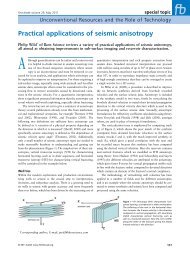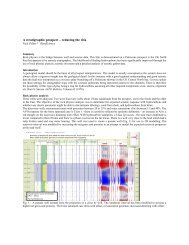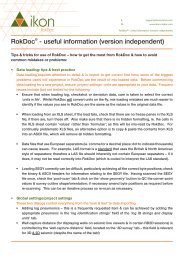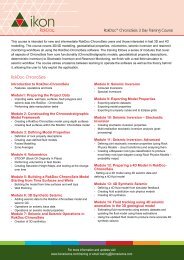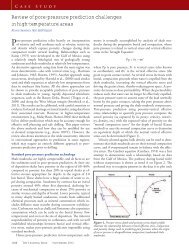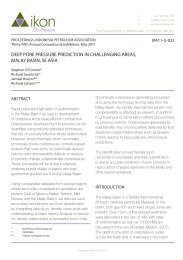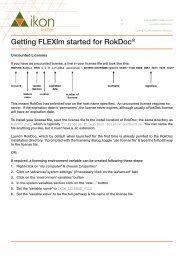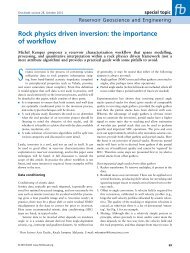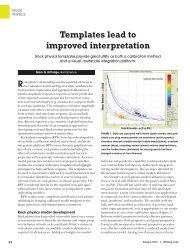Download full Paper (pdf) - Ikon Science
Download full Paper (pdf) - Ikon Science
Download full Paper (pdf) - Ikon Science
Create successful ePaper yourself
Turn your PDF publications into a flip-book with our unique Google optimized e-Paper software.
Seismic Data Conditioning of Partial Stacks for AVO<br />
- using well offset amplitude balancing<br />
E. Efthymiou, H. Morris, M. Kemper, J.D. Kerr<br />
Introduction<br />
AVO analysis is increasingly becoming part of the everyday workflow, however it is often found that<br />
existing data sets require further conditioning in order to extract accurate reservoir properties within<br />
the zones of interest. We present a systematic workflow which incorporates the understanding taken<br />
from the well based AVO analysis to align the seismic data to the true AVO signal of the earth.<br />
Rock Physics analysis of well data from 4 wells intersecting the same geological formation has<br />
concluded that the best lithology and fluid discriminators are Intercept and Gradient reflectivities<br />
along with their associated Acoustic and Gradient impedances. The theoretical AVO response derived<br />
from well data over the field area was consistent enough to provide high confidence. This AVO<br />
modelling suggested that at the top reservoir level we should observe a strong positive gradient. The<br />
gradient reflectivity derived from P-wave partial stacks did not match with the theoretical AVO<br />
response (Figure 4a).<br />
Routine seismic processing does not prepare the data for input in a quantitative AVO analysis as<br />
noted by Ross and Beale (1994) and Martinez (1993). Noise in the P-wave seismic data mainly in the<br />
form of wavelet variations with offset and residual NMO corrections will significantly bias shear<br />
information (Cambois, 2000). In order to get more comparable seismic data with the theoretical AVO<br />
response a seismic data conditioning workflow on P-wave partial stacks was applied. In this paper I<br />
will outline the main steps of this workflow. ( Fig(1) )<br />
Figure 1: <strong>Ikon</strong> <strong>Science</strong> Q.I. - Seismic Data Conditioning workflow
Seismic Data Conditioning is more commonly known as an exercise performed on prestack gathers,<br />
however it is also applicable to partial stacks. Seismic data conditioning of the partial stacks is<br />
considered as a cost effective, progressive, alternative to seismic data conditioning of the prestack<br />
gathers<br />
Seismic data conditioning workflow<br />
All seismic partial stacks need to obtain the same phase and polarity in order to undergo spectral<br />
balancing. Well based analysis undertaken previously highlighted that the partial stacks were slightly<br />
out from zero phase. Subtle corrections would align the phase character of the wavelet with offset.<br />
The following steps were key to the analysis:<br />
1. Zero Phasing - The character of the wavelet discovered during the well analysis was used to<br />
correct the Near stack to zero phase.<br />
2. Spectral Balancing - Spectral and phase differences were corrected by designing and applying<br />
matching filters to match the Mid and Far stack to the Near stack.<br />
3. Time Alignment - misalignments were corrected.<br />
4. Offset Balancing - Knowledge gained from AVO analysis of the well data was used to<br />
balance the offset amplitudes. Fig(2) shows well synthetics used for background amplitude<br />
calculation.<br />
Figure 2: RokDoc - Well synthetic background amplitude analysis.<br />
A small subset was extracted from the partial stacks for testing of different Seismic Data Conditioning<br />
algorithms. Optimum results rely on the ability to compare the various parameter settings and modify<br />
them accordingly. The seismic data conditioning workflow tries to correct for phase, frequency,<br />
amplitude and time differences. Once the exact procedure was outlined and tested, the workflow was<br />
applied and reviewed throughout the entire volume.
Conclusions<br />
• The seismic post conditioning was successful in making the partial stacks more comparable.<br />
Each step progressively improved the final results of creating an improved Intercept and<br />
Gradient reflectivity. ( fig(3) )<br />
a) b)<br />
Figure 3: Amplitude extraction at the top reservoir from the Gradient reflectivity before (a) and after<br />
(b) seismic data conditioning. After seismic conditioning the gradient now matches the theoretical<br />
response as observed at the wells.<br />
• A phase rotation of about 30 degrees was required for both the Mid and Far stacks to match<br />
the Zero phased Near stack.<br />
• The Mid stack did not require heavy time alignment. At the reservoir level the time shifts<br />
were of the order of 3ms. Nevertheless for quantitative generation of Intercept and Gradient<br />
reflectivities, 3ms is enough to add noise to the end products.<br />
• The Far stack required on average more time alignment than the Mid stack. At the reservoir<br />
level the time shifts were of the order of 10ms. The alignment significantly improved the end<br />
products of Intercept and Gradient.<br />
• More comparable wavelets between seismic cubes highlight the improvements of the Seismic<br />
Data conditioning (Figure 4)<br />
• The final stacks honour the knowledge gained from well data analysis. The wells and the<br />
seismic now share the same dynamic range of AVO characteristics as those seen at the wells.<br />
• A significant factor in improving the data was the conditioning of the amplitudes to honour<br />
the AVO characteristics seen at the wells.
a) b)<br />
Figure 4: Exctracted wavelets from the Raw P-wave stacks (a) and the post conditioned P-wave<br />
stacks (b).<br />
References<br />
1. Ross, C. P., Beale P. L.,1994, Seismic offset balancing. Geophysics, 59, 93-101.<br />
2. Cambois G., 2000, Can P-wave AVO be quantitative? The Leading Edge 19, 1246-1251<br />
3. Martinez, R.D., 1993, Wave propagation effects on amplitude variation with offset measurements:<br />
A modelling study. Geophysics, 58, 534-543.<br />
4. Morris, H., Hardy, B., Efthymiou, E., 2009, Rock Physics Reservoir Characterisation of Dolomitic<br />
sand Reservoir. Poster presentation, PGCE 2010 Conference.<br />
Acknowledgements<br />
We would like to thank Salamander Energy, for allowing the use of their seismic data in this paper.




